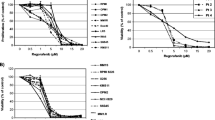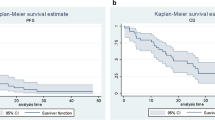Abstract
Imatinib mesylate is used in targeted therapy of cancer to inhibit type III tyrosine kinase receptors, such as KIT and platelet-derived growth factor receptors (PDGFRs). Expression of KIT in uveal melanoma (UM) suggests that this receptor may be the target of imatinib mesylate therapy. However, phase II multicenter clinical studies have shown no effect of imatinib mesylate in patients with unresectable liver metastases of UM. We therefore investigated which molecular mechanisms promote imatinib mesylate-resistance in metastatic UM. Expression of KIT, stem cell factor (SCF), PDGFRα and PDGFRβ, was analyzed by RT-PCR, immunostaining, and Western blot in twenty-four samples of UM liver metastases, as well as UM primary tumor and metastatic cell lines. Soluble SCF was quantified in UM cell lines using enzyme-linked immunosorbent assay. Cell viability of UM cell lines treated with imatinib mesylate and grown in SCF-supplemented medium or in microvascular endothelial cells-conditioned medium was studied by MTT (3-[4,5-dimethylthiazol-2-yl]-2,5 diphenyl tetrazolium bromide) assays. UM liver metastases and cell lines expressed KIT and SCF, but not the PDGFRs. Ninety-five percent of liver metastases expressed KIT at the protein level, but PDGFRs were not detected in these samples. Imatinib mesylate reduced the viability of UM metastatic cell lines in a concentration-dependent manner, but an increased resistance to this drug was observed when cells were incubated in SCF-supplemented or microvascular endothelial cells-conditioned medium. This study provides evidence that tumor microenvironment cytokines such as SCF may promote resistance to imatinib mesylate in metastatic UM.





Similar content being viewed by others
References
Singh AD, Turell ME, Topham AK (2011) Uveal melanoma: trends in incidence, treatment, and survival. Ophthalmology 118:1881–1885
Hawkins BS (2011) Collaborative ocular melanoma study randomized trial of I-125 brachytherapy. Clin Trials 8:661–673
Harbour JW, Onken MD, Roberson ED, Duan S, Cao L, Worley LA, Council ML, Matatall KA, Helms C, Bowcock AM (2010) Frequent mutation of BAP1 in metastasizing uveal melanomas. Science 330:1410–1413
Tschentscher F, Prescher G, Horsman DE, White VA, Rieder H, Anastassiou G, Schilling H, Bornfeld N, Bartz-Schmidt KU, Horsthemke B, Lohmann DR, Zeschnigk M (2001) Partial deletions of the long and short arm of chromosome 3 point to two tumor suppressor genes in uveal melanoma. Cancer Res 61:3439–3442
Onken MD, Worley LA, Tuscan MD, Harbour JW (2010) An accurate, clinically feasible multi-gene expression assay for predicting metastasis in uveal melanoma. J Mol Diagn 12:461–468
Collaborative Ocular Melanoma Study Group (2001) Assessment of metastatic disease status at death in 435 patients with large choroidal melanoma in the collaborative ocular melanoma study (COMS): COMS report no. 15. Arch Ophthalmol 119:670–676
Augsburger JJ, Correa ZM, Shaikh AH (2009) Effectiveness of treatments for metastatic uveal melanoma. Am J Ophthalmol 148:119–127
Weber A, Hengge UR, Urbanik D, Markwart A, Mirmohammadsaegh A, Reichel MB, Wittekind C, Wiedemann P, Tannapfel A (2003) Absence of mutations of the BRAF gene and constitutive activation of extracellular-regulated kinase in malignant melanomas of the uvea. Lab Invest 83:1771–1776
Zuidervaart W, van Nieuwpoort F, Stark M, Dijkman R, Packer L, Borgstein AM, Pavey S, van der Velden P, Out C, Jager MJ, Hayward NK, Gruis NA (2005) Activation of the MAPK pathway is a common event in uveal melanomas although it rarely occurs through mutation of BRAF or RAS. Br J Cancer 92:2032–2038
Onken MD, Worley LA, Long MD, Duan S, Council ML, Bowcock AM, Harbour JW (2008) Oncogenic mutations in GNAQ occur early in uveal melanoma. Invest Ophthalmol Vis Sci 49:5230–5234
Van Raamsdonk CD, Bezrookove V, Green G, Bauer J, Gaugler L, O’Brien JM, Simpson EM, Barsh GS, Bastian BC (2009) Frequent somatic mutations of GNAQ in uveal melanoma and blue naevi. Nature 457:599–602
Van Raamsdonk CD, Griewank KG, Crosby MB, Garrido MC, Vemula S, Wiesner T, Obenauf AC, Wackernagel W, Green G, Bouvier N, Sozen MM, Baimukanova G, Roy R, Heguy A, Dolgalev I, Khanin R, Busam K, Speicher MR, O’Brien J, Bastian BC (2010) Mutations in GNA11 in uveal melanoma. N Engl J Med 363:2191–2199
Pereira PR, Odashiro AN, Marshall JC, Correa ZM, Belfort R Jr, Burnier MN Jr (2005) The role of c-kit and imatinib mesylate in uveal melanoma. J Carcinog 4:19
Lefevre G, Glotin AL, Calipel A, Mouriaux F, Tran T, Kherrouche Z, Maurage CA, Auclair C, Mascarelli F (2004) Roles of stem cell factor/c-Kit and effects of Glivec/STI571 in human uveal melanoma cell tumorigenesis. J Biol Chem 279:31769–31779
Mouriaux F, Kherrouche Z, Maurage CA, Demailly FX, Labalette P, Saule S (2003) Expression of the c-kit receptor in choroidal melanomas. Melanoma Res 13:161–166
Mouriaux F, Chahud F, Maurage CA, Malecaze F, Labalette P (2001) Implication of stem cell factor in the proliferation of choroidal melanocytes. Exp Eye Res 73:151–157
Capdeville R, Buchdunger E, Zimmermann J, Matter A (2002) Glivec (STI571, imatinib), a rationally developed, targeted anticancer drug. Nat Rev Drug Discov 1:493–502
Buchdunger E, Cioffi CL, Law N, Stover D, Ohno-Jones S, Druker BJ, Lydon NB (2000) Abl protein-tyrosine kinase inhibitor STI571 inhibits in vitro signal transduction mediated by c-kit and platelet-derived growth factor receptors. J Pharmacol Exp Ther 295:139–145
Heinrich MC, Griffith DJ, Druker BJ, Wait CL, Ott KA, Zigler AJ (2000) Inhibition of c-kit receptor tyrosine kinase activity by STI 571, a selective tyrosine kinase inhibitor. Blood 96:925–932
Deininger M, Buchdunger E, Druker BJ (2005) The development of imatinib as a therapeutic agent for chronic myeloid leukemia. Blood 105:2640–2653
Mauro MJ, O’Dwyer M, Heinrich MC, Druker BJ (2002) STI571: a paradigm of new agents for cancer therapeutics. J Clin Oncol 20:325–334
Matei D, Chang DD, Jeng MH (2004) Imatinib mesylate (Gleevec) inhibits ovarian cancer cell growth through a mechanism dependent on platelet-derived growth factor receptor alpha and Akt inactivation. Clin Cancer Res 10:681–690
Fiorentini G, Rossi S, Lanzanova G, Bernardeschi P, Dentico P, De Giorgi U (2003) Potential use of imatinib mesylate in ocular melanoma and liposarcoma expressing immunohistochemical c-KIT (CD117). Ann Oncol 14:805
Penel N, Delcambre C, Durando X, Clisant S, Hebbar M, Negrier S, Fournier C, Isambert N, Mascarelli F, Mouriaux F (2008) O-Mel-Inib: a Cancero-pole Nord-Ouest multicenter phase II trial of high-dose imatinib mesylate in metastatic uveal melanoma. Invest New Drugs 26:561–565
Hofmann UB, Kauczok-Vetter CS, Houben R, Becker JC (2009) Overexpression of the KIT/SCF in uveal melanoma does not translate into clinical efficacy of imatinib mesylate. Clin Cancer Res 15:324–329
Pache M, Glatz K, Bosch D, Dirnhofer S, Mirlacher M, Simon R, Schraml P, Rufle A, Flammer J, Sauter G, Meyer P (2003) Sequence analysis and high-throughput immunohistochemical profiling of KIT (CD 117) expression in uveal melanoma using tissue microarrays. Virchows Arch 443:741–744
McLean IW, Foster WD, Zimmerman LE, Gamel JW (1983) Modifications of Callender’s classification of uveal melanoma at the armed forces institute of pathology. Am J Ophthalmol 96:502–509
Mouriaux F, Casagrande F, Pillaire MJ, Manenti S, Malecaze F, Darbon JM (1998) Differential expression of G1 cyclins and cyclin-dependent kinase inhibitors in normal and transformed melanocytes. Invest Ophthalmol Vis Sci 39:876–884
Kan-Mitchell J, Mitchell MS, Rao N, Liggett PE (1989) Characterization of uveal melanoma cell lines that grow as xenografts in rabbit eyes. Invest Ophthalmol Vis Sci 30:829–834
De Waard-Siebinga I, Blom DJ, Griffioen M, Schrier PI, Hoogendoorn E, Beverstock G, Danen EH, Jager MJ (1995) Establishment and characterization of an uveal-melanoma cell line. Int J Cancer 62:155–161
Chen PW, Murray TG, Uno T, Salgaller ML, Reddy R, Ksander BR (1997) Expression of MAGE genes in ocular melanoma during progression from primary to metastatic disease. Clin Exp Metastasis 15:509–518
Labialle S, Dayan G, Gambrelle J, Gayet L, Barakat S, Devouassoux-Shisheboran M, Bernaud J, Rigal D, Grange JD, Baggetto LG (2005) Characterization of the typical multidrug resistance profile in human uveal melanoma cell lines and in mouse liver metastasis derivatives. Melanoma Res 15:257–266
Folberg R, Kadkol SS, Frenkel S, Valyi-Nagy K, Jager MJ, Pe’er J, Maniotis AJ (2008) Authenticating cell lines in ophthalmic research laboratories. Invest Ophthalmol Vis Sci 49:4697–4701
Seftor EA, Meltzer PS, Kirschmann DA, Pe’er J, Maniotis AJ, Trent JM, Folberg R, Hendrix MJ (2002) Molecular determinants of human uveal melanoma invasion and metastasis. Clin Exp Metastasis 19:233–246
Calipel A, Mouriaux F, Glotin AL, Malecaze F, Faussat AM, Mascarelli F (2006) Extracellular signal-regulated kinase-dependent proliferation is mediated through the protein kinase A/B-Raf pathway in human uveal melanoma cells. J Biol Chem 281:9238–9250
Flanagan JG, Chan DC, Leder P (1991) Transmembrane form of the kit ligand growth factor is determined by alternative splicing and is missing in the Sld mutant. Cell 64:1025–1035
Natali PG, Nicotra MR, Winkler AB, Cavaliere R, Bigotti A, Ullrich A (1992) Progression of human cutaneous melanoma is associated with loss of expression of c-kit proto-oncogene receptor. Int J Cancer 52:197–201
Wyman K, Atkins MB, Prieto V, Eton O, McDermott DF, Hubbard F, Byrnes C, Sanders K, Sosman JA (2006) Multicenter phase II trial of high-dose imatinib mesylate in metastatic melanoma: significant toxicity with no clinical efficacy. Cancer 106:2005–2011
Peng B, Hayes M, Resta D, Racine-Poon A, Druker BJ, Talpaz M, Sawyers CL, Rosamilia M, Ford J, Lloyd P, Capdeville R (2004) Pharmacokinetics and pharmacodynamics of imatinib in a phase I trial with chronic myeloid leukemia patients. J Clin Oncol 22:935–942
Weisberg E, Wright RD, McMillin DW, Mitsiades C, Ray A, Barrett R, Adamia S, Stone R, Galinsky I, Kung AL, Griffin JD (2008) Stromal-mediated protection of tyrosine kinase inhibitor-treated BCR-ABL-expressing leukemia cells. Mol Cancer Ther 7:1121–1129
Lotem J, Sachs L (1992) Hematopoietic cytokines inhibit apoptosis induced by transforming growth factor beta 1 and cancer chemotherapy compounds in myeloid leukemic cells. Blood 80:1750–1757
Mol CD, Dougan DR, Schneider TR, Skene RJ, Kraus ML, Scheibe DN, Snell GP, Zou H, Sang BC, Wilson KP (2004) Structural basis for the autoinhibition and STI-571 inhibition of c-Kit tyrosine kinase. J Biol Chem 279:31655–31663
Lennartsson J, Ronnstrand L (2012) Stem cell factor receptor/c-Kit: from basic science to clinical implications. Physiol Rev 92:1619–1649
Boyd SR, Tan DS, de Souza L, Neale MH, Myatt NE, Alexander RA, Robb M, Hungerford JL, Cree IA (2002) Uveal melanomas express vascular endothelial growth factor and basic fibroblast growth factor and support endothelial cell growth. Br J Ophthalmol 86:440–447
Lee JT, Herlyn M (2007) Microenvironmental influences in melanoma progression. J Cell Biochem 101:862–872
Acknowledgments
We thank Dr. Eduardo Angles-Cano and Loïc Doeuvre for providing the HMEC-conditioned medium. This study was supported by a Clinical Research Grant (RC-071-2005) from the Institute National du Cancer (Cancéro-pôle Nord-Ouest).
Conflict of interest
The authors declare that they have no conflict of interest.
Author information
Authors and Affiliations
Corresponding author
Rights and permissions
About this article
Cite this article
Calipel, A., Landreville, S., De La Fouchardière, A. et al. Mechanisms of resistance to imatinib mesylate in KIT-positive metastatic uveal melanoma. Clin Exp Metastasis 31, 553–564 (2014). https://doi.org/10.1007/s10585-014-9649-2
Received:
Accepted:
Published:
Issue Date:
DOI: https://doi.org/10.1007/s10585-014-9649-2




